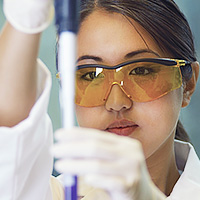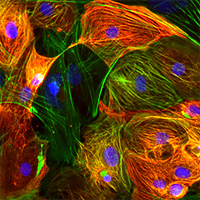- Cellartis Cardiomyocytes (from ChiPSC22) Kit
- Cellartis Cardiomyocytes (from ChiPSC22)
- Cellartis CM Thawing Base
- Cellartis CM Culture Base
- Fetal Bovine Serum (FBS) (Thermo Fisher Scientific, Cat. # 16140063)
- Y-27632
- Fibronectin (Sigma-Aldrich, Cat. No. F0895)
- Maestro MEA 48-well plate (Axion BioSystems, M768-KAP-48)
- PBS Dulbecco’s with Ca2+ & Mg2+ (D-PBS +/+)
- The Maestro MEA System (Axion BioSystems)
- General cell culture equipment used in a cell culture laboratory
User-generated protocol
Cellartis cardiomyocytes on the Maestro MEA system
Cellartis cardiomyocytes are derived from human induced pluripotent stem cells and provide a promising, physiologically relevant, human model for preclinical testing and drug screening. Axion BioSystems' Maestro multi-electrode array (MEA) platform allows for noninvasive detection of extracellular field potential (EFP) recordings in a high-throughput format. Cellartis cardiomyocytes used in combination with Axion BioSystems' MEA technology demonstrates the potential to accurately predict cardiotoxic responses and to screen compound efficacy.
Materials required
Protocol
NOTE: Avoid contact with the electrodes in all of the following procedures as they are extremely fragile. These procedures should be performed under aseptic conditions.
Coating the Maestro 48-well plate
- Dilute the required volume of fibronectin in D-PBS+/+ to a final concentration of 10 µg/ml.
- Add 8 μl/well of the diluted fibronectin solution to the center of each well (on top of the electrodes). Be careful not to touch the electrodes.
NOTE: Rapid plating is preferred to avoid drying of the coating.
- Place the plate in the incubator (37°C ± 1°C, 5% CO2, and >90% humidity) for 1–2 hr.
Preparing the media required for this protocol
Preparing the Cellartis CM Thawing Medium
- Thaw the Cellartis CM Thawing Base.
- Decontaminate the external surfaces of all bottles with an appropriate disinfectant and place into the biological safety cabinet.
- Add 8 ml of FBS per 32 ml Cellartis CM Thawing Base to make Cellartis CM Thawing Medium.
Cellartis CM Thawing Medium should be stored at 4°C and expires one month after the date of preparation.
Always discard any leftover warmed Cellartis CM Thawing Medium.
Preparing Cellartis CM Thawing Medium with Y-27632
- On the day of use, prepare Cellartis CM Thawing Medium with Y-27632 by adding Y-27632 to a final concentration of 10 μM to the previously prepared Cellartis CM Thawing Medium.
- Cellartis CM Thawing Medium with Y-27632 should be used on the day of preparation.
Preparing Cellartis CM Culture Medium
- Thaw the Cellartis CM Culture Base.
- Decontaminate the external surface of the supplement and medium bottles with appropriate disinfectant and place into the biological safety cabinet.
- Add 10 ml of FBS per 90 ml Cellartis CM Culture Base to make Cellartis CM Culture Medium.
- Cellartis CM Culture Medium should be stored at 4°C and expires one month after the date of preparation.
- Always discard any leftover warmed Cellartis CM Culture Medium.
Preparing Cellartis CM Culture Medium with Y-27632
- On the day of use, prepare Cellartis CM Culture Medium with Y-27632 by adding Y-27632 to a final concentration of 10 μM to the previously prepared Cellartis CM Culture Medium.
- Cellartis CM Thawing Medium with Y-27632 should be used on the day of preparation.
Thawing and plating of Cellartis cardiomyocytes
NOTES:
- Do not thaw more than two to three vials at once.
- For your protection, wear a protective face mask and protective gloves. Use forceps when handling a frozen vial. Never hold the vial in your hand as it may explode due to rapid temperature changes.
- Prepare the appropriate volume of Cellartis CM Thawing Medium with Y-27632 and warm to room temperature (RT, 15–25°C).
- Using forceps, quickly transfer the frozen vial from liquid nitrogen to a 37°C ± 1°C water bath.
- Thaw the cells by gently pushing the vial under the surface of the water, without swirling the vial. Do not submerge the cap of the vial in the water bath as this could contaminate the cells.
- Take the vial out of the water bath as soon as the thawing is completed (approximately 3 min; the vial should still be cold on the outside).
- Wipe the vial with an appropriate disinfectant and place into the biological safety cabinet.
- As soon as possible, gently pipet the cell suspension into a sterile 50-ml tube.
- Rinse each vial with 1 ml of Cellartis CM Thawing Medium with Y-27632 and carefully add it to the cell suspension dropwise.
- Add 8 ml of Cellartis CM Thawing Medium with Y-27632 dropwise. Gently swirl the tube a few times in between.
- Centrifuge the tube at 200g for 5 min at RT and remove the supernatant.
- Carefully resuspend the cell pellet with Cellartis CM Thawing Medium with Y-27632, using 700 µl medium per thawed vial.
- Count the cells and measure viability.
- Adjust the number of viable cells to 3,125,000 cells/ml with Cellartis CM Thawing Medium with Y-27632.
- Seed the cells into the previously coated 48-well plate.
NOTE: Aspirate the fibronectin solution just before adding the cell suspension. Prepare 2–4 wells at a time, since drying of the surface might result in crystallization of the fibronectin and subsequent damaging of the cells. Carefully mix your cell suspension before seeding each set of wells, and gently pipet 8 μl of the cell suspension on top of the electrodes in each well (2.5 x 104 cells/well).
- Place the plate in the incubator (37°C ± 1°C, 5% CO2, and >90% humidity) to allow the cells to settle.
- After 1–2 hours, carefully add an additional 390 μl of Cellartis CM Thawing Medium with Y-27632 to each well to reach a final volume of 400 µl.
- Place the plate in the incubator (37°C ± 1°C, 5% CO2, and >90% humidity).
Changing the media
We recommend performing the first media change 48 ± 5 hr after thawing and plating, and every 2–3 days after that (e.g., Monday, Wednesday, Friday).
Preparing the medium
Prepare the appropriate volume of Cellartis CM Culture Medium with Y27632 as previously described and warm to 37°C ± 1°C before use.
Changing the media
NOTE: Work very gently so as not to detach the cells.
- Replace the used media with 400 μl of fresh Cellartis CM Culture Medium with Y-27632.
- Place the plate in the incubator (37°C ± 1°C, 5% CO2, and >90% humidity).
Preparing to perform experiments on the Maestro MEA platform
NOTE: Pharmacological experiments are best conducted on Day 7–9 post-thaw, or when the T-waves are well defined.
On the day of recording, perform a complete media change as described above, but reduce the volume to 300 µl of fresh Cellartis CM Culture Medium with Y-27632.

User-generated protocols
User-generated protocols are based on internal proof-of-concept experiments, customer collaborations, and published literature. In some cases, relevant results are discussed in our research news BioView blog articles. While we expect these protocols to be successful in your hands, they may not be fully reviewed or optimized. We encourage you to contact us or refer to the published literature for more information about these user-generated and -reported protocols.
If you are looking for a product-specific, fully optimized User Manual or Protocol-At-A-Glance, please visit the product's product page, open the item's product details row in the price table, and click Documents. More detailed instructions for locating documents are available on our website FAQs page.
Questions? Protocols of your own that you would like to share?
Contact technical support Give feedbackCellartis hPS cell-derived cardiomyocytes citation list
Publications using Cellartis human pluripotent stem cell-derived cardiomyocytes.
Takara Bio USA, Inc.
United States/Canada: +1.800.662.2566 • Asia Pacific: +1.650.919.7300 • Europe: +33.(0)1.3904.6880 • Japan: +81.(0)77.565.6999
FOR RESEARCH USE ONLY. NOT FOR USE IN DIAGNOSTIC PROCEDURES. © 2025 Takara Bio Inc. All Rights Reserved. All trademarks are the property of Takara Bio Inc. or its affiliate(s) in the U.S. and/or other countries or their respective owners. Certain trademarks may not be registered in all jurisdictions. Additional product, intellectual property, and restricted use information is available at takarabio.com.




